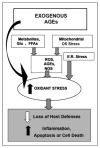Advanced glycation end products (AGE) and diabetes: cause, effect, or both?
- PMID: 24292971
- PMCID: PMC3903318
- DOI: 10.1007/s11892-013-0453-1
Advanced glycation end products (AGE) and diabetes: cause, effect, or both?
Abstract
Despite new and effective drug therapies, insulin resistance (IR), type 2 diabetes mellitus (T2D) and its complications remain major medical challenges. It is accepted that IR, often associated with over-nutrition and obesity, results from chronically elevated oxidant stress (OS) and chronic inflammation. Less acknowledged is that a major cause for this inflammation is excessive consumption of advanced glycation end products (AGEs) with the standard western diet. AGEs, which were largely thought as oxidative derivatives resulting from diabetic hyperglycemia, are increasingly seen as a potential risk for islet β-cell injury, peripheral IR and diabetes. Here we discuss the relationships between exogenous AGEs, chronic inflammation, IR, and T2D. We propose that under chronic exogenous oxidant AGE pressure the depletion of innate defense mechanisms is an important factor, which raises susceptibility to inflammation, IR, T2D and its complications. Finally we review evidence on dietary AGE restriction as a nonpharmacologic intervention, which effectively lowers AGEs, restores innate defenses and improves IR, thus, offering new perspectives on diabetes etiology and therapy.
Conflict of interest statement
Helen Vlassara has received grant support and support for travel to meetings for the study or otherwise from Sanofi for a co-investigator-initiated clinical investigation. She has patents (planned, pending or issued) from Cell Biolabs for development of monoclonal antibody, and receives royalties for monoclonal antibody. Her husband is principal investigator in investigator-initiated clinical trial, supported by Sanofi.
Jaime Uribarri is a co-author on a book on AGE-less Diet.
Figures






Similar articles
-
Oral advanced glycation endproducts (AGEs) promote insulin resistance and diabetes by depleting the antioxidant defenses AGE receptor-1 and sirtuin 1.Proc Natl Acad Sci U S A. 2012 Sep 25;109(39):15888-93. doi: 10.1073/pnas.1205847109. Epub 2012 Aug 20. Proc Natl Acad Sci U S A. 2012. PMID: 22908267 Free PMC article.
-
Cereal polyphenols inhibition mechanisms on advanced glycation end products and regulation on type 2 diabetes.Crit Rev Food Sci Nutr. 2024 Sep;64(26):9495-9513. doi: 10.1080/10408398.2023.2213768. Epub 2023 May 24. Crit Rev Food Sci Nutr. 2024. PMID: 37222572 Review.
-
Restriction of advanced glycation end products improves insulin resistance in human type 2 diabetes: potential role of AGER1 and SIRT1.Diabetes Care. 2011 Jul;34(7):1610-6. doi: 10.2337/dc11-0091. Diabetes Care. 2011. PMID: 21709297 Free PMC article. Clinical Trial.
-
The Role of Dietary Advanced Glycation End Products in Metabolic Dysfunction.Mol Nutr Food Res. 2021 Jan;65(1):e1900934. doi: 10.1002/mnfr.201900934. Epub 2020 Apr 20. Mol Nutr Food Res. 2021. PMID: 32246887 Review.
-
AGE restriction in diabetes mellitus: a paradigm shift.Nat Rev Endocrinol. 2011 May 24;7(9):526-39. doi: 10.1038/nrendo.2011.74. Nat Rev Endocrinol. 2011. PMID: 21610689 Free PMC article. Review.
Cited by
-
The antimicrobial peptide alpha defensin correlates to type 2 diabetes via the advanced glycation end products pathway.Afr Health Sci. 2022 Mar;22(1):303-311. doi: 10.4314/ahs.v22i1.37. Afr Health Sci. 2022. PMID: 36032426 Free PMC article.
-
AGER1 downregulation associates with fibrosis in nonalcoholic steatohepatitis and type 2 diabetes.J Clin Invest. 2020 Aug 3;130(8):4320-4330. doi: 10.1172/JCI133051. J Clin Invest. 2020. PMID: 32657776 Free PMC article.
-
Improved Methods for the Rapid Formation and Prevention of Advanced Glycation End Products (AGEs) In Vitro by Coupling to the Hypoxanthine/Xanthine Oxidase Assay System.Biomedicines. 2018 Aug 15;6(3):88. doi: 10.3390/biomedicines6030088. Biomedicines. 2018. PMID: 30111701 Free PMC article.
-
Antiglycation Activity of Aucubin In Vitro and in Exogenous Methylglyoxal Injected Rats.Molecules. 2019 Oct 10;24(20):3653. doi: 10.3390/molecules24203653. Molecules. 2019. PMID: 31658696 Free PMC article.
-
Cinnamaldehyde ameliorates STZ-induced rat diabetes through modulation of IRS1/PI3K/AKT2 pathway and AGEs/RAGE interaction.Naunyn Schmiedebergs Arch Pharmacol. 2019 Feb;392(2):243-258. doi: 10.1007/s00210-018-1583-4. Epub 2018 Nov 20. Naunyn Schmiedebergs Arch Pharmacol. 2019. PMID: 30460386
References
-
- Amos AF, McCarty DJ, Zimmet P. The rising global burden of diabetes and its complications: estimates and projections to the year 2010. Diabet Med. 1997;14 (Suppl 5):S1–85. - PubMed
-
- Huebschmann AG, Regensteiner JG, Vlassara H, Reusch JE. Diabetes and advanced glycoxidation end products. Diabetes Care. 2006;29:1420–32. - PubMed
-
- Ford ES, Giles WH, Mokdad AH. Increasing prevalence of the metabolic syndrome among U.S. Adults Diabetes Care. 2004;27:2444–9. - PubMed
-
- The effect of intensive treatment of diabetes on the development and progression of long-term complications in insulin-dependent diabetes mellitus. The Diabetes Control and Complications Trial Research Group. N Engl J Med. 1993;329:977–86. No authors listed. - PubMed
-
- Effect of intensive blood-glucose control with metformin on complications in overweight patients with type 2 diabetes (UKPDS 34). UK Prospective Diabetes Study (UKPDS) Group. Lancet. 1998;352:854–65. No authors listed. - PubMed
Publication types
MeSH terms
Substances
Grants and funding
LinkOut - more resources
Full Text Sources
Other Literature Sources
Medical

